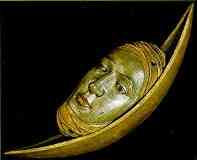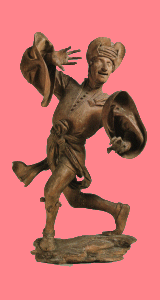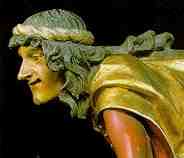|
|
Creation of the wooden Munich Morisken dancers
 The sculptor Erasmus Grasser, born 1450 in Schmidmühlen (Oberpfalz), arrived in Munich
for his apprenticeship around 1470. Initially the young ambitious artist gathered
attention by carving coats of arms and a beautiful wooden sun, and then in 1480
the newly appointed "Meister" (master craftsman) was asked to create
16 wooden dancers for the ballroom of the Munich city hall that was newly erected
by Jörg von Halspach between 1470 and 1474
The sculptor Erasmus Grasser, born 1450 in Schmidmühlen (Oberpfalz), arrived in Munich
for his apprenticeship around 1470. Initially the young ambitious artist gathered
attention by carving coats of arms and a beautiful wooden sun, and then in 1480
the newly appointed "Meister" (master craftsman) was asked to create
16 wooden dancers for the ballroom of the Munich city hall that was newly erected
by Jörg von Halspach between 1470 and 1474
A banquet with dance hosted by Duke Cristoph der Starke (the strong) served as the original inspiration. On August 15. 1480 the town clerk of Munich noted in the books of the Munich chamber of commerce that 150 Gulden were paid to Grasser, a respectable sum in those days. Initially the captivating creations of the self-confident young artist had lead to some envious turmoil among the established master craftsmen. |
 Ten of the dancing figures
were placed on small consoles in a frieze going all around the room right under
the impressive barrel vault, five in a row on each side, where the round arches
intersect, as can be deduced from an engraving produced in 1568 by Nicolas Solis,
depicting the marriage of Wilhelm the Fifth with Renata of Lothringen. The dancers,
each between 61.5 cm and 81.5 cm high, stood for more than 450 years in this
hall. The search for hints about the looks and positions of the remaining six
figures has been futile to this day: Some assume that these might have been
the "Tanzjungfrawe" (the dancing virgin), the joker, musicians and
possibly spectators.
Ten of the dancing figures
were placed on small consoles in a frieze going all around the room right under
the impressive barrel vault, five in a row on each side, where the round arches
intersect, as can be deduced from an engraving produced in 1568 by Nicolas Solis,
depicting the marriage of Wilhelm the Fifth with Renata of Lothringen. The dancers,
each between 61.5 cm and 81.5 cm high, stood for more than 450 years in this
hall. The search for hints about the looks and positions of the remaining six
figures has been futile to this day: Some assume that these might have been
the "Tanzjungfrawe" (the dancing virgin), the joker, musicians and
possibly spectators.
The ten Morisken-figures survived
almost undisturbed for 450 years in the town hall; they were restored twice
(1726 and 1887) until they were replaced by copies in 1928. The original figures
found their final home in the Muenchener Stadtmuseum (city museum) in 1931,
after another restauration in the workshops of the Bavarian National Museum.
After the "Zeughaussaal" (arsenal), with its origin in the late Gothic
period, was remodeled, the figures were again accessible for public viewing
in the Stadtmuseum.
During the years, each figure acquired several nicknames with reference to their
costumes, for example
*
Farmer,
* Burgund or figure with a cone
hat,
* Lady's Hat or figure with
a wheel shaped brim,
* Beau or groom,
* Moor,
* Man from the Middle East or
figure with a little turban,
* Prophet or figure with lace-braided
cap,
* Little Tailor or figure with
a hunter's hat,
* "Zaddelrock" (gown
with fabric flaps) or figure with a high hat,
* Sorcerer or figure with a
lion-head hat.
The Munich Morisken figures are the only artistic rendition that reflects the Morisken dance in three dimensions. The precious wooden sculptures are considered unique in the late medieval art. To carve those figures, Erasmus Grasser must have studied the movements of real dancers. It is unknown how much he was inspired by the dancers that were first mentioned in 1479 in Nuernberg.
Grasser represented his figures as fascinating dancers with highly expressive motions which differed for each character, but shared some common traits. The most typical are the principles of opposition, twisting and isolation that can be rediscovered mainly in modern jazz dance. Crossed legs, contrarotating upper body bending forwards or backwards sometimes combined with a sidewards bend, isolated movement of head and shoulders, grotesquely bent or straight arms with splayed fingers filling all spatial dimensions. The dancers' facial features can be described as slightly older and rather vulgar. Goatees and mustaches are typical.
 All
dancers wear golden or red leggings which emphasize their muscular or slender
legs respectively. The golden upper body garments come in a great variety of
styles, some are fitted, others are slightly baggy with a belt, some have big,
billowing sleeves or a waving cape like the Beau's. The garments differ from
each other through tails that bob up and down while dancing, braid trimmings,
tassels or golden pearls, as well as through a variety of fluttering ribbons
and sashes. Almost every piece of garment, jerkins, shirts, leggings, even hats
is decorated with a varying number of bells of different sizes.
All
dancers wear golden or red leggings which emphasize their muscular or slender
legs respectively. The golden upper body garments come in a great variety of
styles, some are fitted, others are slightly baggy with a belt, some have big,
billowing sleeves or a waving cape like the Beau's. The garments differ from
each other through tails that bob up and down while dancing, braid trimmings,
tassels or golden pearls, as well as through a variety of fluttering ribbons
and sashes. Almost every piece of garment, jerkins, shirts, leggings, even hats
is decorated with a varying number of bells of different sizes.
Eight of the dancers wear highly imaginative hats or head pieces respectively,
which are to some extent influenced by the Middle East or the fashion at court.
Some of them have whitish-brown or dark blue ribbons wrapped around them which
are tied under the chin. The Moor and the Beau show their thick hair wearing
just a braided headband. Characteristic are also the pointed reddish-brown shoes
or boots with turned-up toes; one exception is the "Lady's Hat" whose
boots are gold colored. One dancer, the "Prophet", stands out: in
contrast to his colorful fellow dancers he is completely unpainted; in 1928
during a restauration the figure was stripped off its paint to reveal the wood
carving technique characteristic of Grasser.
Very interesting are also similar contemporary representations of Morisken dancers.
Among the most spectacular is the figured stone relief of the splendid oriel,
subdivided into eight partitions of the "Goldenes Dachl" (golden roof)
in Innsbruck dating back to 1494/96. On it are six couples of grotesque dancers
dressed up as jesters and in their midst the emperor Maximilian in profile with
his second wife, who obviously serves as a judge with a golden sphere or an
apple respectively, and his late first wife. The emperor is represented a second
time from the front with a councilman and a jester.
There are graphic illustrations amongst others by Israel von Meckenem around
1460/Gaisberg 383 and 465, Hans Suess of Kulmbach around 1510, Meister HL around
1520, Christoph Weiditz around 1530 and Erhard Schoen around 1542.
Illustrations repeatedly show a dancing woman, the jester and the piper. Similarities
in movements and costumes with the Munich dancers can be found in the illustrations
by Israel von Meckenem and in the figures of the "Goldenes Dachl"
in Innsbruck. Two Illustrations of Grasser's Morisken dancers by Wilhelm Gail
dating back to the year 1860 are part of the graphic collection of the "Muenchner
Stadtmuseum". Presumably they are sketches of vignettes that were produced
for the program guides of artist parties.
Gertrude Krombholz